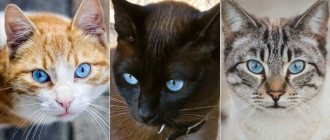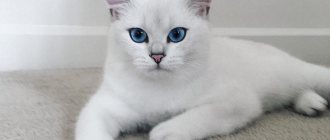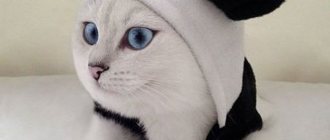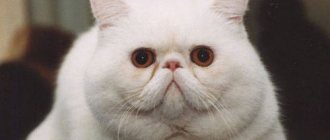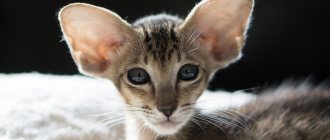Everyone knows that cats have keen eyesight. This has been proven in practice. Cats have special, very sensitive photoreceptors inside their eyes that can detect the slightest source of light reflected from any object. It is precisely due to the fact that even a small light from the moon makes all objects visible to them that they lead a predominantly nocturnal lifestyle and do not experience any discomfort in the dark. They can navigate with the help of lighting, which is provided by the distant light of car headlights, star rays and similar light sources, which are clearly not enough for a person. At night, as you can see, the pupils of cats are wide open, which allows the slightest fraction of light in the surrounding space to pass through.
Shining eyes – magic or physiology?
In fact, the glow of cat eyes is somewhat of a misconception. The fact is that on the inside of a cat’s eye (like any other animal capable of nocturnal existence), there is a special transparent (“luminous”) layer - tapetum. It consists of guanine (a nitrogenous base) and various pigments that give the animal’s eye a particular color (yellow or green in cats, dark brown or green-blue in dogs, milky white in fish, etc.). The stratum lucidum plays an important role for cats. The fact is that not the entire light beam is perceived by photoreceptors. The tapetum reflects the “remnants” of light onto the retina, as a result of which many more signals enter the brain. In this regard, the answer to the question why cats’ eyes glow becomes quite obvious: so that they can see better at dusk and, accordingly, hunt.
Do cat eyes glow in pitch darkness?
But the question of why a cat’s eyes glow at night is not formulated entirely correctly. And the answer to the popular riddle “How to find a black cat in a dark room?” There is really only one option - turn on the light. In absolute darkness, the tapetum simply has nothing to reflect; accordingly, a “glow” will appear only if there is a light source of at least minimal intensity. And if you point, for example, a flashlight towards the animal, the eyes will “flare up” very brightly.
The eyes can “catch” the reflection from a street lamp, the glare of a crystal chandelier, or the light from the screen of a tablet or phone. Of course, one of the main night sources is the moon. Therefore, even if it seems to us that the room is very dark, the lights are turned off, you can still see that same shine.
Sometimes it is so intense that it is even a little scary. The “force” depends on the angle at which the light beam falls on the eye, and at which the person looks at the cat. The brightest reflected rays are those hitting the retina at an angle of 45 degrees, if you look exactly “in the face” of the animal.
The cats themselves do not feel this effect in any way. This conclusion can be drawn by the absence of squinting during the appearance of the glow.
But if a bright beam falls directly, the cat will definitely close her eyes. Indeed, in this case there will be an “overload”, overstimulation of the light receptors of the retina. In turn, in a bright room during the day it is almost impossible to catch the glow effect, because the light penetrates completely into the eye, and the animal sees well without any reflection.
First aid for eye disease
We found out what might be hiding behind a cat's red eye. Now we’ll tell you how to help your pet in the initial stages of illness.
For conjunctivitis, wash the eyes with strong brewed black tea. Or herbs such as sage, chamomile and calendula.
Wipe the eyes several times a day (from 4 to 6). Use a new cotton swab each time. It is moistened in the solution and, without pressing too hard on the eye, it is passed from its outer corner to the animal’s nose.
Under no circumstances should tea leaves or herbal infusions be placed in the eye. Not only will this not help, but it will also make the situation worse.
Red eye effect
It would be interesting to note that a person’s eyes can also “glow”. Of course, this property is much less pronounced, because we are freed from the need for night vision. However, a similar layer still exists in the human eye. That is why, in conditions of not very good lighting, the eyes begin to glow red in the photo from a bright flash.
Thus, the glowing eyes of cats are not magic at all, but an adaptive element.
Glowing cat eyes served as the basis for the emergence of a huge number of superstitions, fairy tales and hypotheses. Since ancient times, people have been interested in why cats' eyes glow in the dark? What are the reasons for this effect in nocturnal animals? How does this help cats see perfectly and why don’t humans have a similar feature?
Eye injury
If a foreign body gets in, the cat’s eye is red; the animal does not allow him to touch it due to severe pain. There are two options here:
- Remove the irritant yourself if it is on the surface and the owner sees it.
- Go to a veterinary clinic if the object is inside the eye or for some reason the cat owner cannot remove it when it is on the surface of the organ.
Scientific explanation
In the dark, cats' eyes glow due to their ability to reflect light that hits them. By themselves, they are not able to produce any radiation, so in complete darkness there will be no glow. The principle of operation of a cat's visual organs is the same as that of human eyes, but there is one significant difference that causes the glow at night - the tapetum.
The inside of a cat's eyes is covered with a layer of transparent cells called the tapetum. It is the similarity of this layer to a mirror that causes the reflection of light and, as a result, the glow. Even the faintest reflection, passing through the cornea and lens, is not fully absorbed, but is reflected and returned back by a thin beam of light. It is this feature of the structure of the eyes of felines that allows them to see excellently in the dark.
The color of the glow may vary depending on the pigment located in the tapetum
:
- green;
- yellow;
- bluish;
- in Siamese cats it is crimson in color.
A cat's eyes are 7 times superior to human eyes in their ability to discern images in the dark. People may also experience a faint red glow. This is clearly noticeable when photographing using a bright flash.
Allergic reaction
The owner discovered red spots near the cat's eyes. With what it can be connected? One option is allergies. Analyze what could have caused it. Have you changed the food? Did the cat eat something from the table? Have you tried a new cat weed? If the animal owner answered yes to one of these questions, then the following steps will have to be taken:
- Return to the cat’s usual diet.
- Closely monitor the animal so that it does not climb on the tables.
- Remove everything edible from the table.
- Return to the previous variety of cat grass.
As a rule, allergies go away on their own after the pet returns to its comfort zone.
If none of the above happened, and the red spots formed on their own, then it is advisable to go to a veterinary hospital in order to accurately diagnose and remove the cause of the formation of redness in the eyes.
Why is this necessary?
The cat's glow-in-the-dark eyes provide signal amplification and improved image quality in the dark. This is explained by the fact that a weak ray of light penetrates the retina, is reflected from the tapetum and re-enters the retina, but now enhancing the signal and improving the visibility of the picture.
It is thanks to the built-in amplifier that cats perfectly distinguish objects even in the light of the stars. This allows them to be nocturnal and accurately strike in conditions of almost complete darkness by human standards. A cat is able to see the movement of objects from seven hundred meters away and can distinguish them perfectly from a distance of one to 57 meters.
In the dark, a cat’s eyes glow and at the same time can not blink thanks to the existing third eyelid. It performs protective functions and prevents the eye from drying out, which is achieved by moving fluid.
The human eye responds to bright lighting by making the pupils very narrow (they narrow). In cats, the pupils transform into long narrow slits. This property allows the animal to regulate the amount of light that enters the organs of vision. It is the ability to control the intensity of light that distinguishes cats from other animals.
Previously, there was a hypothesis that cats see all objects as gray. The basis for this conclusion was that this is not necessary, because in the dark all images look in shades of gray. It is now a scientifically proven fact that cats distinguish the color spectrum, but much worse than humans.
Noticing a cat's eyes burning in the dark, a person sees only the reflection of a beam of light reflected from the tapetum.
Who posted
Site administration
People at all times have endowed cats with mystical abilities. In part, this statement is not without meaning, but still, there is a scientific basis for any mysterious phenomena associated with these animals. One of these phenomena, which has stirred the imaginations of people for many centuries of coexistence, is the almost mystical glow of a cat's eyes in the dark.
Features of the structure of a cat's eye
Cats are nocturnal. It is life with a person that changes their routine and forces them to adapt to the rhythms of family members. Nevertheless, nature takes its toll, and cats are still more awake at night than during the day. In complete darkness, a cat can navigate perfectly not only with the help of hearing, but also thanks to the unique structure of its eyes.
Cats have binocular vision, that is, they see one object at the same time with two eyes, which are located on the front of the face.
It is important for cats to focus their gaze on prey so as not to go hungry
By comparison, herbivores have peripheral vision. That is, the eyes are located on the sides of the skull. They have a viewing angle of more than 320 degrees, which allows them to notice danger in time. A cat's viewing angle reaches 285°, but it is more important for predators to focus their attention on one object - the prey.
A cat's eye consists of 3 layers:
- Fibrous - the outer layer of the eye. They form a fibrous sheath of collagen fibers and protein elastin. The outer layer of the eye is made up of the sclera, which covers approximately 3/4 of the eye's area, and the cornea, which covers the remainder. The function of the cornea is to receive light and transmit it inside the eye for subsequent processing.
- Vascular. It is located immediately behind the fibrous layer and forms a middle layer penetrated by tiny blood vessels. They organize the nutrition of eye tissues with various substances and oxygen. In front of the middle layer is the ciliary (ciliary) body. Next comes the eye lens, which is held in place by the muscles of the ciliary body.
- The retina is the third, inner layer. Consists of light-sensitive cells that are responsible for converting light into nerve impulses for subsequent transmission to the brain via the optic nerve. In cats, like in humans, there are two types of photoreceptors: rods - provide light reception, transmit it through themselves, which forms vision;
- Cones - responsible for image clarity, the ability to see small details and color perception.
The iris is located in front of the ciliary body. This is the colored area of the eye. It divides the eye into two chambers: external and internal. The color of the iris is determined by the amount of pigment. It is finally formed by the age of two. This is why kittens are born with blue eyes, and by the age of one month their color begins to change.
The cat's eye is a very complex and delicate organ, it is made up of many functional parts that together provide the cat with the ability to see.
In the center of the iris there is a black pupil, which changes its size with changes in the level of illumination to regulate the intensity of the light flux entering the eyes: it narrows in bright light, and in dim light it expands to let in maximum light.
The vertical pupil allows different species of animals to see equally well both at night and during the day
Tapetum and its main function
The main difference between the structure of a cat's eye and a human's is the presence of another special layer - tapetum lucidum. The tapetum is located at the back of the eyeball and reflects light not absorbed by the photoreceptors back to the retina.
The tapetum is a kind of “mirror” created by nature.
This is the culprit behind the mysterious glow of cat’s eyes. Or rather, a cat’s eyes themselves do not glow in the dark, but as soon as a certain amount of light hits them, they reflect it like a mirror.
Humans also have a tapetum, but only another variety of it - tapetum nigrum, which is practically devoid of reflective pigment.
Cat's eye color spectrum
Cat eyes come in a variety of shades. But there are 4 main colors: yellow, green, blue and copper.
All kittens are born with blue-gray eyes. With age (starting from 1 month) their color changes. By the age of one year, a cat’s iris is at its most saturated, but by old age it fades. In purebred cats, eye color is very often linked according to the laws of genetics with color or with belonging to a particular breed.
For example, all color point cats have blue eyes. These are not only Siamese cats, but also Persians, British, Neva Masquerade and representatives of some other breeds.
A typical combination of color point color and blue eyes is the Thai cat.
Cats also have heterochromia, that is, eyes of different colors. Mostly white animals have this feature. This trait is inherited. By the way, heterochromic eyes glow in the dark in two different colors.
This is actually true. My mother has a cat with heterochromia. I don’t know to what extent this trait was passed on to him by inheritance; he was one of the kittens found in the trash and raised by my cat. We noticed his different eye colors after he was thoroughly licked by my dog when he was a month old. So heterochromia could be a consequence of injury, although vision was not affected. His eyes glow in different colors in the dark: blue - red, brown - green. I'm not very impressionable, but it looks at least unusual.
Other Features
For a long time it was believed that cats see everything in black and white. But recently the opinion of scientists has changed. Studies of the structure of the cat's eye have proven that cats are able to distinguish colors.
Of course, they do not need the entire range of colors available to humans. But a cat, for example, distinguishes 25 shades of gray, but does not perceive green and does not see red at all. All shades of blue and yellow are available to the cat; the cat sees black well.
Some scientists believe that cats are color blind.
Cat eye glow process
As mentioned above, a special layer, the tapetum, is responsible for the glow of the eyes in the dark. This interesting coating of the choroid is somewhat similar to mother of pearl. The smallest particles of light that the photoreceptors could not catch fall on the mirror surface of the tapetum and return to the retina. This is how the glow occurs. The tapetum is colored yellow or green, and in blue-eyed felines it is red.
By the way, in absolute darkness cats are completely blind. They are forced to rely only on their hearing and move with the help of another unique organ - vibrissae (special hard hairs that perform the function of touch, a kind of cat navigation system).
In complete darkness there will be no glow in the eyes. For this effect to occur, the slightest light source is required. It’s interesting, but the glow of a cat’s eyes repeats the physical process of releasing sunbeams.
The glow of a cat's eyes in the dark is based on the same reflection of light as when launching a sunbeam through a mirror
Video: why cats' eyes glow in the dark
Prevention
It is easier to prevent a disease than to treat it. It would seem like such a hackneyed phrase. But how accurate is it? Instead of spending large sums on treating your pet, follow these tips to prevent eye diseases:
- All discharge is removed daily with a damp cotton swab. You can moisten it either in water or in chamomile infusion, for example.
- If your pet develops “tear tracks,” they are removed with a cotton swab, preventing them from drying out near the eyes.
- Did you have to bathe your cat? Be careful not to get shampoo into your eyes. Otherwise, a chemical burn cannot be ruled out.
- If your cat has long hair, you need to be careful not to let it get into your eyes. Some owners trim the hair above the eyes.
Lack of glow in the cat's eyes
The lack of glow in the eyes should alert owners. The cause can be anything: internal diseases and various injuries.
Is it a pathology?
The absence of glow is a direct indication of the development of pathological processes in the body.
This pathology occurs against the background of a lack of certain substances. At the same time, the functioning of the lenses and the entire layer deteriorates. The sulfonic acid taurine and a number of other amino acids are responsible for the bright glow of the eyes. Cats get taurine from food of animal origin. Unlike other animals that can produce taurine on their own, cats do not have this ability. Therefore, the deterioration in the brightness of the glow or its absence directly indicates an acute shortage of this element.
How to treat
To prevent the occurrence of pathological conditions of the eyeball, namely vision problems, it is necessary to give the cat vitamins containing taurine. As a rule, this substance is included in many foods or is contained in complex dietary supplements for cats. But you shouldn’t solve the problem yourself by adding dietary supplements to your pet’s diet; you should first consult with a veterinarian.
Do I need to contact a veterinarian?
If you suspect problems with your pet's vision, you should show it to a specialist. Unfortunately, many eye diseases occur hidden and are noticed by owners already at a critical stage, when it is almost impossible to do anything.
Of course, you shouldn’t chase a cat around a dark apartment, but you can take at least a couple of pictures with a flash. The absence of “flashlights” in the photo is a direct indication of a visit to the veterinarian.
The eyes of a cat with healthy vision will definitely glow in a photo with a flash.
Legends and superstitions associated with glowing eyes in cats
There are many legends associated with cats and their eyes. There are those in which cats are considered evil creatures, but there are also opposing legends:
For thousands of years, people have lived next to cats. These amazing and mysterious animals captivate people with their refined grace, beauty and gentle manners. At different times, humanity idolized cats, equating them to deities, such as in Ancient Egypt. In Japan, tailless cats were revered, and this is how the Japanese Bobtail breed appeared. Statues of such cats can still be found in many houses on the Japanese islands. And in the Middle Ages in Europe, people were afraid of cats, burning black cats at the stake along with their mistresses, considering unfortunate women to be witches.
There are many superstitions and signs associated with cats; some still believe that meeting a black cat on the street does not bode well. But cats have managed to conquer human hearts; these furry creatures live in almost every family. And no matter how well we know our furry friends, they are still surrounded by many secrets and mysteries. How do cats anticipate earthquakes, how do cats find their way home several hundred kilometers away, and, of course, why do a cat’s eyes glow in the dark? The glowing eyes of a cat in the dark have become the basis for many stories, fairy tales, and this image is often used in cinema.
Nevertheless, there is a completely scientific explanation for the effect of a cat’s glowing eyes.
.
Like most predatory animals that are nocturnal, cat's eyes are designed in such a way that any light, even the faint reflection of the moon or the glow of stars, can be reflected in them. The eyes themselves, of course, do not produce any light
. You can do a little experiment yourself. If you lock your cat in a dark room without windows, make sure that in absolute darkness its eyes do not glow.
A cat's eyes are capable of reflecting light from an external source: the slight glow of the night sky, the bright flash of car headlights - and the cat's eyes become like small spotlights. The thing is that the inside of a cat's eye is covered with a layer of shiny transparent cells.
, which is called
tapetum
. The silvery tapetum is very similar to a mirror, and it is it that is capable of reflecting light. Even the weakest ray of light entering through the lens and cornea is not completely absorbed, but is reflected back by a thin beam of light. This feature helps cats see well at night.
The glow color of the eyes of various animals depends on the pigment present in the tapetum. In cats it is most often yellow and green. Other shades may be much less common. For example, in Siamese cats the pigment of the tapetum is crimson.
A cat's eyes are seven times more sensitive than human eyes.
. But even in people you can observe a weak glow effect if you use a bright flash. So sometimes in color photos people’s eyes can glow red.
Share this important information with your friends on social networks!
Preventive actions
Among the basic rules of prevention are the following:
- Carefully ensure that the cat does not injure its eyes when playing with other animals.
- When swimming, do not allow detergents to get into your eyes. This often leads to irritation.
- Hygienic procedures are carried out using products that do not provoke the development of an allergic reaction.
- Regularly wipe the corners of the animal's eyes with cotton swabs.
- Avoid getting hair in the eyes of long-haired animals.
Swelling and redness are the first symptoms of the onset of the inflammatory process.
If you notice that the cat begins to actively scratch the eye area, you should instill drops of artificial tears twice a day. With their help, it will be possible to eliminate irritation and dry mucous membranes.
It would be a good idea to consult a veterinarian. Pathologies at the initial stage are easier to treat.
Special protective collars will help prevent scratching of the affected area.
The best way to prevent ophthalmological pathologies is a caring and attentive attitude to the health of your pet.
The appearance of any negative changes or symptoms of inflammation is a reason to immediately contact a veterinarian.
This is the only way to preserve vision and avoid serious health problems for the animal.
Historical background: cat's eyes and superstitions
Cats' eyes glow due to reflection.
Cats in Europe, starting from the 14th century (the beginning of the Catholic Inquisition), were considered messengers of the devil and assistants to witches. The origins of these superstitions were supposedly glowing in the dark cat eyes, their vertical pupils and natural cat independence. Black cats were especially disliked, apparently for their fantastic ability to dissolve in the dark. Embittered fanatics burned beautiful girls and their cats, thereby permanently impoverishing the gene pool of both in nearby European areas.
Interesting fact:
In ancient times, cats were considered protectors, hunters, and sometimes even idolized. Since ancient times, cats have been considered special animals; pagans believed that cats were messengers of the god Rod, the so-called “prelagatai”, observing what was happening on earth and transmitting the collected information to the gods. The legends that have come down to us say that Makosh, the ancient Slavic goddess of water, asked the clan for an observer to look after the people. Rod thought and created a furry domestic creature that walks between the boundaries of reality and will warn people about approaching trouble. He distributed one to all the gods and sent several to earth so that they would multiply and protect the home of each family.
Excursion into history
In European states, starting from the fourteenth century, all representatives of the cat family were considered servants of the devil and the first companions of witches. These superstitions appeared precisely because people could not answer the questions: why do a cat’s eyes glow in the dark , their pupils are vertical, and why is she too independent and independent? Black cats were especially persecuted; they were probably not loved because of how quickly they could hide in the dark. Enraged fanatics burned beautiful girls along with cats, thus depleting the gene pool of both in those dark times.
Did you know? In more ancient times, cats were considered protectors, excellent hunters and even deities. In many countries they were indeed considered special; according to pagan beliefs, these animals were messengers of the god Rod, those who were sent to observe life on earth and then convey the information received to the gods. Legends that have survived to this day say that Makosh, the goddess of water, revered by the ancient Slavs, asked the god Rod for someone who could look after people. Rod thought about it, and then created a mustachioed creature that moves between the boundaries of reality and warns the human race about approaching disasters. He gave one cat to each of the gods, and sent several down to multiply and keep human homes.
Why do cats' eyes actually glow?
But biology does not agree with superstitious people. Moreover, cat's eyes do not glow in the literal sense of the word: they only reflect light.
Cats see better in the dark than humans.
To simplify, the process of obtaining an image by the brain can be described as follows: light reflected from objects passes through the pupil into the lens, through it it is imprinted on the retina, which captures the light and rewrites it into an electrical signal (neural impulse) entering the occipital lobe of the cortex cerebral hemispheres. At the stage when light hits the retina, the so-called “glow” of a cat’s eyes appears.
Behind the retina is a layer of reflective cells
– tapetum, a special layer of the choroid. It is divided into two types - tapetum lucidum and tapetum nigrum. In all species of animals it is expressed differently, and even within a species, depending on the breed, the ratio of one and another type of tapetum, its location may change. Tapetum L. in cats is located in the form of a diamond or triangle and occupies a large area. Light hitting the retina passes through it, is reflected from the tapetum and falls back on the retina, strengthening the signal and providing a better image. This is why cats only need the faint light of the stars and moon - they have a built-in amplifier in their eyeballs that allows them to see at night. And seeing eyes sparkling in the dark, we are observing just reflections of reflected light.
Interesting fact:
This system for improving night vision is another remarkable invention of evolution. Not only cats can boast of eyes sparkling in the darkness: all nocturnal predators, to one degree or another, have similar abilities. Owls, for example, see 10 times better in the dark than cats, and are able to detect the movement of a mouse 300 meters away; but during the day they are practically helpless, since their eyes are too sensitive for bright daylight. The marsupial loris, a resident of Australia, has huge eyes and ears, as it hunts insects at night, and has adapted to hear and see even a praying mantis crawling by.
Green and red
The color of the reflected light is also explained by the properties of the tapetum. Tapetum L. produces a predominantly yellow, green, and bluish glow. Tapetum N. practically does not change the reflected light, so we see a red glow - from the blood vessels of the choroid. Depending on the angle of incidence of light and the location of the tapetum, we can see how the eyes glow green - when reflected from Tapetum L., or a reddish dim glow - these are reflections from Tapetum N. Interestingly, the eyes glow red even in humans - remember these reflections on Polaroid photos, red eye effect? It is also a reflection of the flash in our eyes. Humans do not have such a powerful tool for enhancing night vision as cats do, so our tapetum is practically invisible - unless you point a flashlight directly at the eye, of course.
Conjunctivitis
This is an inflammation of the protective membrane of the eye (conjunctiva). If your cat's eye is red and pus-filled, sticky and watery, he could have contracted conjunctivitis.
There are two types of disease: caused by a bacterial infection and viral. In the first case, the disease develops very quickly, in the second - quite slowly.
It is important to consider that the eyes do not always fester with conjunctivitis. The cat's eye is red. Or both eyes. A colorless mucous liquid flows out of them. And these secretions “slow down” the rapid recognition of the disease. This is a viral form of the disease.
If the pet has contracted bacterial conjunctivitis, then there may be no redness of the eyes. But purulent discharge is a prerequisite for the development of the disease.
How to treat the disease? Firstly, only a veterinarian can make an accurate diagnosis. He will prescribe antibacterial or antiviral medications that are necessary for treatment.

